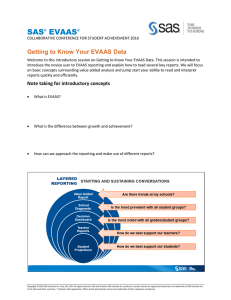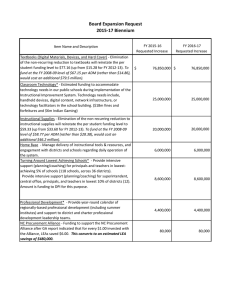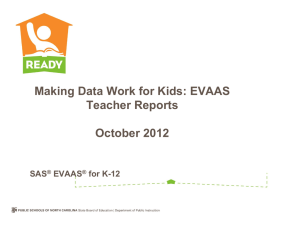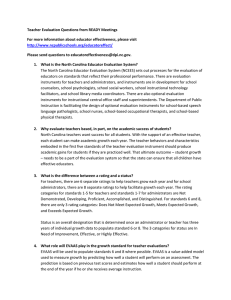Educator Effectiveness Model Update Jennifer Preston, Race to the Top Project Coordinator
advertisement
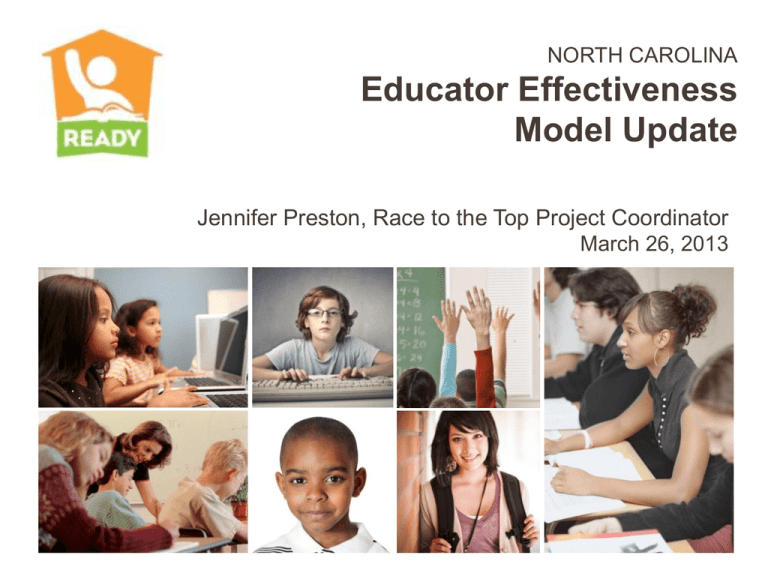
NORTH CAROLINA Educator Effectiveness Model Update Jennifer Preston, Race to the Top Project Coordinator March 26, 2013 Agenda What • Setting do wethe need? Context • Revisions to TCP-C-006 • Update on Common Exams • Review of Resources for Teachers • Focus on Inter-Rater Reliability 3/25/13 • page 2 Setting the Context 3/25/13 • page 3 Standards 6 & 8 Teachers 1 2 3 4 5 6 Demonstrate Establish Leadership Environment Know Content Facilitate Learning Contribute Reflect on Practice to Academic Success Principals (and other Administrators) 1 2 3 4 5 6 7 8 Strategic Leadership Instructional Leadership Cultural Leadership Human Resource Leadership Managerial Leadership External Development Leadership Micropolitical Leadership Academic Achievement Leadership 3/25/13 • page 4 Growth Model Teachers 6 Contribute to Academic Success Principals 8 Standard 6 and 8 are measures of Growth Academic Academic Achievement Leadership Achievement Leadership 3/25/13 • page 5 Growth Model Teachers 6 Contribute to Academic Success Principals 8 Academic Academic Achievement Leadership Achievement The State Board of Education selected Educator Value-Added Assessment System EVAAS for standards 6 & 8 when possible Leadership 3/25/13 • page 6 Ratings Teachers 6 Contribute to Academic Success Principals How will the ratings on Standards 6 & 8 work? 8 Academic Academic Achievement Leadership Achievement Leadership 3/25/13 • page 7 Teacher Ratings Categories Teachers 1 2 3 4 5 Demonstrate Leadership Establish Environment Know Content 5 Rating Categories Not Demonstrated Developing Proficient Accomplished Distinguished Facilitate Learning Reflect on Practice 6 Contribute to Academic Success 3 Rating Categories Does Not Meet Expected Growth Meets Expected Growth Exceeds Expected Growth 3/25/13 • page 8 Teacher Ratings in 2011-12 Baseline Data Yearly Rating Teacher EVAAS Growth School-wide EVAAS Growth • Does not Meet Expected Growth 6 • Meets Expected Growth 70% 30% Weighted Average • Exceeds Expected Growth Why was school-wide EVAAS growth included? • To encourage collaboration and collective ownership of overall outcomes. Note: In 2011-12, teachers without individual EVAAS growth values had school-wide growth for Standard 6. Teacher Ratings in 2011-12 Unintended Consequences Analysis with the sixth standard ratings of teachers with their own EVAAS growth values uncovered two disturbing trends: 2,853 (9.7%) teachers who met or exceeded expected growth with their own students were pulled down one entire rating due to the inclusion of school-wide growth. 3/25/13 • page 10 Teacher Ratings in 2011-12 Unintended Consequences Furthermore, 2,647 (9.0%) teachers who did not meet or met growth with their own students were pushed up one entire rating due to the inclusion of school-wide growth. 3/25/13 • page 11 Teacher Ratings in 2011-12 Unintended Consequences The inclusion of school-wide growth hurt highperforming teachers working in low-performing schools and discourages high-performing teachers from working in the schools where they are needed most. The inclusion of school-wide growth hid the performance of low-performing teachers working in high-performing schools. 3/25/13 • page 12 Revisions to TCP-C-006 Policy including Standard 6 Teacher Ratings in 2012-13 First Year Counting Toward Status Yearly Rating Teacher EVAAS Growth School-wide EVAAS Growth ?? ?? Weighted Average • Does not Meet Expected Growth 6 • Meets Expected Growth • Exceeds Expected Growth Critical Change during 2012-13: With the administration of the Common Exams, approximately 70% of NC’s teachers will have individual EVAAS growth values. Recommendation: Standard 6 Teacher EVAAS Growth 100% Yearly Rating • Does not Meet Expected Growth 6 • Meets Expected Growth • Exceeds Expected Growth In 2012-13, teachers without individual EVAAS growth values receive a sixth standard rating based on school-wide growth. The rating does not count toward overall status. 3/25/13 • page 15 The Importance of Teacher Collaboration Collaboration with colleagues is found in: ü Standard One ü Standard Two ü Standard Three ü Standard Four ü Standard Five 3/25/13 • page 16 Administrator Ratings in 2011-12 Baseline Data School-wide EVAAS Growth 100% Yearly Rating • Does not Meet Expected Growth 8 • Meets Expected Growth • Exceeds Expected Growth In 2011-12, only results from End-of-Grade and End-of-Course assessments were included in the school-wide EVAAS growth scores. 3/25/13 • page 17 Recommendation: Standards 6 and 8 End-of-Grade Assessments CTE PostAssessments Common Exams End-of-Course Assessments EVAAS School-wide Growth Value for Standards 6* and 8 * Only for use in the Standard 6 ratings of teachers without their own growth values 3/25/13 • page 18 Processes to Measure Growth 6 Contribute to Academic Success Academic Academic Achievement Leadership Achievement Leadership 6 End of Grade or End of Course 6 Common Exams 6 Career Technical Education Assessment 6 Grade 3 6 K-2 Literacy 6 Analysis of Student Work 3/25/13 • page 19 Updates to Common Exams Fall 2012/Winter 2013 Thirty-nine school districts and a regional school administered the exams at the end of first semester. In total, districts administered 86,546 exams. District staff and teachers have provided feedback to DPI. 3/25/13 • page 21 Summary of Changes • Shortened exam length (especially for English Language Arts and mathematics). • Added specificity to scoring rubrics. • Revised structure of test books. • Revised scoring module to include additional examples. • Provided assistance with administration scripts. 3/25/13 • page 22 Reviewing the Resources 3/25/13 • page 23 Teacher Evaluation Dashboards Teacher evaluation dashboards present educators with all evaluation data in one place and allow them to track progress toward status. Teacher Evaluation Dashboards. 3/25/13 • page 24 EVAAS Learning Modules Learning Modules allow teachers to have 24/7 access to training on the most-used EVAAS teacher reports. EVAAS Learning Modules. 3/25/13 • page 25 Common Exam Scoring Module Scoring module provides teachers with sample questions and student responses, along with videos of “master scoring.” Common Exam Scoring Module. 3/25/13 • page 26 Focus on Inter-Rater Reliability Inter-Rater Reliability Inter-Rater Reliability is critical to ensuring a fair and valid educator effectiveness model Training on Inter-Rater Reliability. 3/25/13 • page 28 Contact Information General Information: educatoreffectiveness@dpi.nc.gov http://www.ncpublicschools.org/educatoreffect/ 3/25/13 • page 29
